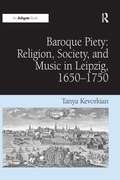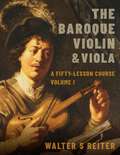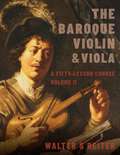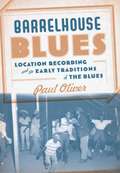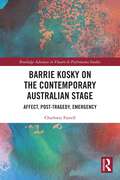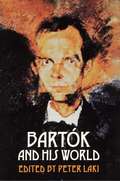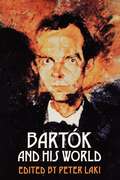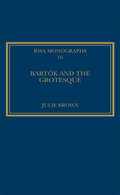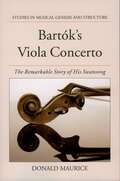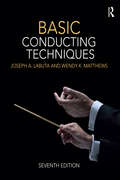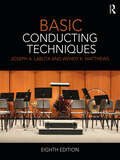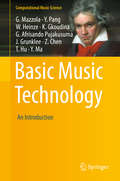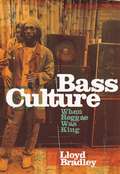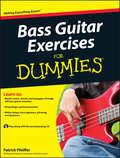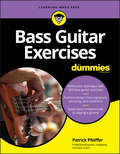- Table View
- List View
Baroque Piety: Religion, Society, and Music in Leipzig, 1650-1750
by Tanya KevorkianDrawing upon a rich array of sources from archives in Leipzig, Dresden and Halle, Tanya Kevorkian illuminates culture in Leipzig before and during J.S. Bach's time in the city. Working with these sources, she has been able to reconstruct the contexts of Baroque and Pietist cultures at key periods in their development much more specifically than has been done previously. Kevorkian shows that high Baroque culture emerged through a combination of traditional frameworks and practices, and an infusion of change that set in after 1680. Among other forms of change, new secular arenas appeared, influencing church music and provoking reactions from Pietists, who developed alternative meeting, networking and liturgical styles. The book focuses on the everyday practices and active roles of audiences in public religious life. It examines music performance and reception from the perspectives of both 'ordinary' people and elites. Church services are studied in detail, providing a broad sense of how people behaved and listened to the music. Kevorkian also reconstructs the world of patronage and power of city councillors and clerics as they interacted with other Leipzig inhabitants, thereby illuminating the working environment of J.S. Bach, Telemann and other musicians. In addition, Kevorkian reconstructs the social history of Pietists in Leipzig from 1688 to the 1730s.
Baroque Piety: Religion, Society, and Music in Leipzig, 1650-1750
by Tanya KevorkianDrawing upon a rich array of sources from archives in Leipzig, Dresden and Halle, Tanya Kevorkian illuminates culture in Leipzig before and during J.S. Bach's time in the city. Working with these sources, she has been able to reconstruct the contexts of Baroque and Pietist cultures at key periods in their development much more specifically than has been done previously. Kevorkian shows that high Baroque culture emerged through a combination of traditional frameworks and practices, and an infusion of change that set in after 1680. Among other forms of change, new secular arenas appeared, influencing church music and provoking reactions from Pietists, who developed alternative meeting, networking and liturgical styles. The book focuses on the everyday practices and active roles of audiences in public religious life. It examines music performance and reception from the perspectives of both 'ordinary' people and elites. Church services are studied in detail, providing a broad sense of how people behaved and listened to the music. Kevorkian also reconstructs the world of patronage and power of city councillors and clerics as they interacted with other Leipzig inhabitants, thereby illuminating the working environment of J.S. Bach, Telemann and other musicians. In addition, Kevorkian reconstructs the social history of Pietists in Leipzig from 1688 to the 1730s.
The Baroque Violin & Viola: A Fifty-Lesson Course Volume I
by Walter S. ReiterIn the early seventeenth century, enthusiasm for the violin swept across Europe--this was an instrument capable of bewitching virtuosity, with the power to express emotions in a way only before achieved with the human voice. With this new guide to the Baroque violin, and its close cousin, the Baroque viola, distinguished performer and pedagogue Walter Reiter puts this power into the hands of today's players. Through fifty lessons based on the Reiter's own highly-renowned course at The Royal Conservatory of the Hague, The Baroque Violin & Viola, Volume I provides a comprehensive exploration of the period's rich and varied repertoire. Volume I covers the basics of choosing a violin, techniques to produce an ideal sound, and sonatas by Vivaldi and Corelli. Practical exercises are integrated into each lesson, and accompanied by rich video demonstrations on the book's companion website. Brought to life by Reiter's deep insight into key repertoire based on a lifetime of playing and teaching, The Baroque Violin & Viola, Volume I: A Fifty-Lesson Course will enhance performances of professional and amateur musicians alike.
BAROQUE VIOLIN & VIOLA, V2 C: A Fifty-Lesson Course
by Walter S. ReiterIn the early seventeenth century, enthusiasm for the violin swept across Europe--this was an instrument capable of bewitching virtuosity, with the power to express emotions in a way only before achieved with the human voice. With this new guide to the Baroque violin, and its close cousin, the Baroque viola, distinguished performer and pedagogue Walter Reiter puts this power into the hands of today's players. Through fifty lessons based on the Reiter's own highly-renowned course at The Royal Conservatory of the Hague, The Baroque Violin & Viola, Volume II provides a comprehensive exploration of the period's rich and varied repertoire. The lessons in Volume II cover the early seventeenth-century Italian sonata, music of the French Baroque, the Galant style, and the sonatas of composers like Schmelzer, Biber, and Bach. Practical exercises are integrated into each lesson, and accompanied by rich video demonstrations on the book's companion website. Brought to life by Reiter's deep insight into key repertoire based on a lifetime of playing and teaching, The Baroque Violin & Viola, Volume II: A Fifty-Lesson Course will enhance performances of professional and amateur musicians alike.
The Baroque Violin & Viola, vol. II: A Fifty-Lesson Course
by Walter S. ReiterIn the early seventeenth century, enthusiasm for the violin swept across Europe--this was an instrument capable of bewitching virtuosity, with the power to express emotions in a way only before achieved with the human voice. With this new guide to the Baroque violin, and its close cousin, the Baroque viola, distinguished performer and pedagogue Walter Reiter puts this power into the hands of today's players. Through fifty lessons based on the Reiter's own highly-renowned course at The Royal Conservatory of the Hague, The Baroque Violin & Viola, Volume II provides a comprehensive exploration of the period's rich and varied repertoire. The lessons in Volume II cover the early seventeenth-century Italian sonata, music of the French Baroque, the Galant style, and the sonatas of composers like Schmelzer, Biber, and Bach. Practical exercises are integrated into each lesson, and accompanied by rich video demonstrations on the book's companion website. Brought to life by Reiter's deep insight into key repertoire based on a lifetime of playing and teaching, The Baroque Violin & Viola, Volume II: A Fifty-Lesson Course will enhance performances of professional and amateur musicians alike.
BAROQUE VIOLIN & VIOLA C: A Fifty-Lesson Course Volume I
by Walter S. ReiterIn the early seventeenth century, enthusiasm for the violin swept across Europe--this was an instrument capable of bewitching virtuosity, with the power to express emotions in a way only before achieved with the human voice. With this new guide to the Baroque violin, and its close cousin, the Baroque viola, distinguished performer and pedagogue Walter Reiter puts this power into the hands of today's players. Through fifty lessons based on the Reiter's own highly-renowned course at The Royal Conservatory of the Hague, The Baroque Violin & Viola, Volume I provides a comprehensive exploration of the period's rich and varied repertoire. Volume I covers the basics of choosing a violin, techniques to produce an ideal sound, and sonatas by Vivaldi and Corelli. Practical exercises are integrated into each lesson, and accompanied by rich video demonstrations on the book's companion website. Brought to life by Reiter's deep insight into key repertoire based on a lifetime of playing and teaching, The Baroque Violin & Viola, Volume I: A Fifty-Lesson Course will enhance performances of professional and amateur musicians alike.
Barrelhouse Blues: Location Recording and the Early Traditions of the Blues
by Paul OliverIn the 1920s, Southern record companies ventured to cities like Dallas, Atlanta, and New Orleans, where they set up primitive recording equipment in makeshift studios. They brought in street singers, medicine show performers, pianists from the juke joints and barrelhouses. The music that circulated through Southern work camps, prison farms, and vaudeville shows would be lost to us if it hadn't been captured on location by these performers and recorders.Eminent blues historian Paul Oliver uncovers these folk traditions and the circumstances under which they were recorded, rescuing the forefathers of the blues who were lost before they even had a chance to be heard. A careful excavation of the earliest recordings of the blues by one of its foremost experts, Barrelhouse Blues expands our definition of that most American style of music.
Barrie Kosky on the Contemporary Australian Stage: Affect, Post-Tragedy, Emergency (Routledge Advances in Theatre & Performance Studies)
by Charlotte FarrellThis is the first book-length study of Australian theatre productions by internationally-renowned director, Barrie Kosky. Now a prolific opera director in Europe, Barrie Kosky on the Contemporary Australian Stage accounts for the formative years of Kosky's career in Australia. This book provides in-depth engagements with select productions including The Dybbuk which Kosky directed with Gilgul theatre company in 1991, as well as King Lear (1998), The Lost Echo (2006), and Women of Troy (2008). Using affect theory as a prism through which these works are analysed, the book accounts for the director's particular engagement with – and radical departure from – classical tragedy in contemporary performance: what the book defines as Kosky's 'post-tragedies'. Theatre studies scholars and students, particularly those with interests in affect, contemporary performance, 'director's theatre', and tragedy, will benefit from Barrie Kosky on the Contemporary Australian Stage’s vivid engagement with Kosky's work: a director who has become a singular figure in opera and theatre of international critical acclaim.
Barrie Kosky on the Contemporary Australian Stage: Affect, Post-Tragedy, Emergency (Routledge Advances in Theatre & Performance Studies)
by Charlotte FarrellThis is the first book-length study of Australian theatre productions by internationally-renowned director, Barrie Kosky. Now a prolific opera director in Europe, Barrie Kosky on the Contemporary Australian Stage accounts for the formative years of Kosky's career in Australia. This book provides in-depth engagements with select productions including The Dybbuk which Kosky directed with Gilgul theatre company in 1991, as well as King Lear (1998), The Lost Echo (2006), and Women of Troy (2008). Using affect theory as a prism through which these works are analysed, the book accounts for the director's particular engagement with – and radical departure from – classical tragedy in contemporary performance: what the book defines as Kosky's 'post-tragedies'. Theatre studies scholars and students, particularly those with interests in affect, contemporary performance, 'director's theatre', and tragedy, will benefit from Barrie Kosky on the Contemporary Australian Stage’s vivid engagement with Kosky's work: a director who has become a singular figure in opera and theatre of international critical acclaim.
Bartók and His World (The Bard Music Festival #50)
by Peter LakiBéla Bartók, who died in New York fifty years ago this September, is one of the most frequently performed twentieth-century composers. He is also the subject of a rapidly growing critical and analytical literature. Bartók was born in Hungary and made his home there for all but his last five years, when he resided in the United States. As a result, many aspects of his life and work have been accessible only to readers of Hungarian. The main goal of this volume is to provide English-speaking audiences with new insights into the life and reception of this musician, especially in Hungary. Part I begins with an essay by Leon Botstein that places Bartók in a large historical and cultural context. László Somfai reports on the catalog of Bartók's works that is currently in progress. Peter Laki shows the extremes of the composer's reception in Hungary, while Tibor Tallián surveys the often mixed reviews from the American years. The essays of Carl Leafstedt and Vera Lampert deal with his librettists Béla Balázs and Melchior Lengyel respectively. David Schneider addresses the artistic relationship between Bartók and Stravinsky. Most of the letters and interviews in Part II concern Bartók's travels and emigration as they reflected on his personal life and artistic evolution. Part III presents early critical assessments of Bartók's work as well as literary and poetic responses to his music and personality.
Bartók and His World (PDF)
by Peter LakiBéla Bartók, who died in New York fifty years ago this September, is one of the most frequently performed twentieth-century composers. He is also the subject of a rapidly growing critical and analytical literature. Bartók was born in Hungary and made his home there for all but his last five years, when he resided in the United States. As a result, many aspects of his life and work have been accessible only to readers of Hungarian. The main goal of this volume is to provide English-speaking audiences with new insights into the life and reception of this musician, especially in Hungary. Part I begins with an essay by Leon Botstein that places Bartók in a large historical and cultural context. László Somfai reports on the catalog of Bartók's works that is currently in progress. Peter Laki shows the extremes of the composer's reception in Hungary, while Tibor Tallián surveys the often mixed reviews from the American years. The essays of Carl Leafstedt and Vera Lampert deal with his librettists Béla Balázs and Melchior Lengyel respectively. David Schneider addresses the artistic relationship between Bartók and Stravinsky. Most of the letters and interviews in Part II concern Bartók's travels and emigration as they reflected on his personal life and artistic evolution. Part III presents early critical assessments of Bartók's work as well as literary and poetic responses to his music and personality.
Bartók and the Grotesque: Studies in Modernity, the Body and Contradiction in Music
by Julie BrownThe grotesque is one of art's most puzzling figures - transgressive, comprising an unresolveable hybrid, generally focussing on the human body, full of hyperbole, and ultimately semantically deeply puzzling. In Bluebeard's Castle (1911), The Wooden Prince (1916/17), The Miraculous Mandarin (1919/24, rev. 1931) and Cantata Profana (1930), Bart ngaged scenarios featuring either overtly grotesque bodies or closely related transformations and violations of the body. In a number of instrumental works he also overtly engaged grotesque satirical strategies, sometimes - as in Two Portraits: 'Ideal' and 'Grotesque' - indicating this in the title. In this book, Julie Brown argues that Bart concerns with stylistic hybridity (high-low, East-West, tonal-atonal-modal), the body, and the grotesque are inter-connected. While Bart eveloped each interest in highly individual ways, and did so separately to a considerable extent, the three concerns remained conceptually interlinked. All three were thoroughly implicated in cultural constructions of the Modern during the period in which Bart as composing.
Bartók and the Grotesque: Studies in Modernity, the Body and Contradiction in Music
by Julie BrownThe grotesque is one of art's most puzzling figures - transgressive, comprising an unresolveable hybrid, generally focussing on the human body, full of hyperbole, and ultimately semantically deeply puzzling. In Bluebeard's Castle (1911), The Wooden Prince (1916/17), The Miraculous Mandarin (1919/24, rev. 1931) and Cantata Profana (1930), Bart ngaged scenarios featuring either overtly grotesque bodies or closely related transformations and violations of the body. In a number of instrumental works he also overtly engaged grotesque satirical strategies, sometimes - as in Two Portraits: 'Ideal' and 'Grotesque' - indicating this in the title. In this book, Julie Brown argues that Bart concerns with stylistic hybridity (high-low, East-West, tonal-atonal-modal), the body, and the grotesque are inter-connected. While Bart eveloped each interest in highly individual ways, and did so separately to a considerable extent, the three concerns remained conceptually interlinked. All three were thoroughly implicated in cultural constructions of the Modern during the period in which Bart as composing.
Bartok's Viola Concerto: The Remarkable Story of His Swansong (Studies In Musical Genesis, Structure, and Interpretation)
by Donald MauriceWhen Bela Bartók died in September of 1945, he left a partially completed viola concerto commissioned by the virtuoso violist William Primrose. Yet, while no definitive version of the work exists, this concerto has become arguably the most-performed viola concerto in the world. The story of how the concerto came to be, from its commissioning by Primrose to its first performance to the several completions that are performed today is told here in Bartók's Viola Concerto:The Remarkable Story of His Swansong. After Bartók's death, his family asked the composer's friend Tibor Serly to look over the sketches of the concerto and to prepare it for publication. While a draft was ready, it took Serly years to assemble the sketches into a complete piece. In 1949, Primrose finally unveiled it, at a premiere performance with the Minneapolis Symphony Orchestra. For almost half a century, the Serly version enjoyed great popularity among the viola community, even while it faced charges of inauthenticity. In the 1990s, several revisions appeared and, in 1995, the composer's son, Peter Bartók, released a revision, opening the way or an intensified debate on the authenticity of the multiple versions. This debate continues as violists and Bartók scholars seek the definitive version of this final work of Hungary's greatest composer. Bartók's Viola Concerto tells the story of the genesis and completion of Bartók's viola concerto, its reception over the second half of the twentieth century, its revisions, and future possibilities.
Basic Conducting Techniques
by Joseph A. Labuta Wendy K. MatthewsBasic Conducting Techniques, Seventh Edition, provides a clear and intelligible introduction to the art of conducting an ensemble. Over the course of fourteen chapters, the authors explicate the elements of conducting, supplementing their teachings with an extensive selection of musical examples from the classical repertoire. Practical and innovative, clear and approachable, this text illuminates the essential skills a beginning conductor should develop to lead and rehearse a performing group. This new edition features: chapters rewritten to highlight important information and show connections between different sections a new chapter on expressive conducting, consisting of expanded and updated content select full scores in the "Musical Excerpts" section excerpts with transpositions for each chapter, allowing easy access for class performance a new companion website, which includes the scores and transpositions for all musical excerpts, audio recordings of the excerpts, and demonstration videos modeling specific techniques for each chapter. With the beginning conductor in mind, this hands-on, competency-centered approach is appropriate for mixed classes of choral and instrumental music majors, providing indispensable versatility for students and practicing conductors alike. Rooted in decades of teaching and conducting experience, Basic Conducting Techniques is the essential guide to the principles of conducting.
Basic Conducting Techniques
by Joseph A. Labuta Wendy K. MatthewsBasic Conducting Techniques, Seventh Edition, provides a clear and intelligible introduction to the art of conducting an ensemble. Over the course of fourteen chapters, the authors explicate the elements of conducting, supplementing their teachings with an extensive selection of musical examples from the classical repertoire. Practical and innovative, clear and approachable, this text illuminates the essential skills a beginning conductor should develop to lead and rehearse a performing group. This new edition features: chapters rewritten to highlight important information and show connections between different sections a new chapter on expressive conducting, consisting of expanded and updated content select full scores in the "Musical Excerpts" section excerpts with transpositions for each chapter, allowing easy access for class performance a new companion website, which includes the scores and transpositions for all musical excerpts, audio recordings of the excerpts, and demonstration videos modeling specific techniques for each chapter. With the beginning conductor in mind, this hands-on, competency-centered approach is appropriate for mixed classes of choral and instrumental music majors, providing indispensable versatility for students and practicing conductors alike. Rooted in decades of teaching and conducting experience, Basic Conducting Techniques is the essential guide to the principles of conducting.
Basic Conducting Techniques
by Joseph A. Labuta Wendy K. MatthewsNow in its eighth edition, Basic Conducting Techniques provides a clear and intelligible introduction to the art of conducting an ensemble. It has been updated with a greater diversity of repertoire, including contemporary examples and more music by underrepresented composers. Over the course of 14 chapters, the authors explicate the elements of conducting, supplementing their teachings with an extensive selection of musical examples from the classical repertoire. Practical and innovative, clear and approachable, the book illuminates the essential skills that a beginning conductor should develop in order to lead and rehearse a performing group. The companion website provides scores and transposed parts for all musical excerpts, as well as guitar and piano parts, audio recordings of the excerpts, and updated demonstration videos modeling specific conducting techniques. With the beginning conductor in mind, this hands-on, competency-centered approach is appropriate for mixed classes of choral and instrumental music majors, providing indispensable versatility for students and practicing conductors alike. Utilizing decades of teaching and conducting experience, the eighth edition of Basic Conducting Techniques is the essential guide to the principles of conducting.
Basic Conducting Techniques
by Joseph A. Labuta Wendy K. MatthewsNow in its eighth edition, Basic Conducting Techniques provides a clear and intelligible introduction to the art of conducting an ensemble. It has been updated with a greater diversity of repertoire, including contemporary examples and more music by underrepresented composers. Over the course of 14 chapters, the authors explicate the elements of conducting, supplementing their teachings with an extensive selection of musical examples from the classical repertoire. Practical and innovative, clear and approachable, the book illuminates the essential skills that a beginning conductor should develop in order to lead and rehearse a performing group. The companion website provides scores and transposed parts for all musical excerpts, as well as guitar and piano parts, audio recordings of the excerpts, and updated demonstration videos modeling specific conducting techniques. With the beginning conductor in mind, this hands-on, competency-centered approach is appropriate for mixed classes of choral and instrumental music majors, providing indispensable versatility for students and practicing conductors alike. Utilizing decades of teaching and conducting experience, the eighth edition of Basic Conducting Techniques is the essential guide to the principles of conducting.
A basic guide to playing the Clarinet (UEB Contracted)
by Markeaton SchoolThis is a simple four-page guide to the basics of clarinet playing. There is a diagram of a clarinet on page one, an introduction to reading music on pages two and three, and how to play the notes E, D and C on the clarinet, on page four.
Basic Music Technology
by Guerino Mazzola Yan Pang William Heinze Kyriaki Gkoudina Gian Afrisando Pujakusuma Jacob Grunklee Zilu Chen Tianxue Hu Yiqing MaThis is an introduction to basic music technology, including acoustics for sound production and analysis, Fourier, frequency modulation, wavelets, and physical modeling and a classification of musical instruments and sound spaces for tuning and counterpoint. The acoustical theory is applied to its implementation in analogue and digital technology, including a detailed discussion of Fast Fourier Transform and MP3 compression. Beyond acoustics, the book discusses important symbolic sound event representation and software as typically realized by MIDI and denotator formalisms. The concluding chapters deal with globalization of music on the Internet, referring to iTunes, Spotify and similar environments. The book will be valuable for students of music, music informatics, and sound engineering.
Bass Culture: When Reggae Was King
by Lloyd BradleyThe first major account of the history of reggae, black music journalist Lloyd Bradley describes its origins and development in Jamaica, from ska to rock-steady to dub and then to reggae itself, a local music which conquered the world. There are many extraordinary stories about characters like Prince Buster, King Tubby and Bob Marley. But this is more than a book of music history: it relates the story of reggae to the whole history of Jamaica, from colonial island to troubled independence, and Jamaicans, from Kingston to London.
Bass Guitar Exercises For Dummies
by Patrick PfeifferLearn to play bass guitar quickly and easily with this guide and bonus interactive CD! The bass guitar is utilized in almost every single genre of music-rock, classical, jazz, metal, funk, and country just to name a few. Bass Guitar Exercises For Dummies provides bassists an opportunity to dabble with all these styles and more. Regardless of your intended musical style, this hands-on guide provides the tips and drills designed to help perfect your playing ability. Features a wide variety of over 300 exercises and technique-building practice opportunities tailored to bass guitar From classic blues bass rhythms to funk, rock, and reggae bass patterns, players of all styles benefit from the exercises and chords presented Shows you proper hand and body posture and fingering and hand positions Each lesson concludes with a music piece for you to try The audio CD includes practice pieces that accompany the exercises and drills presented in each section Helps you build your strength, endurance, and dexterity when playing bass Whether you're a beginner bass player or you're looking to stretch your playing skills, Bass Guitar Exercises For Dummies is the book for you! CD-ROM/DVD and other supplementary materials are not included as part of the e-book file, but are available for download after purchase.
Bass Guitar Exercises For Dummies
by Patrick PfeifferLearn to play bass guitar quickly and easily with this guide and bonus interactive CD! The bass guitar is utilized in almost every single genre of music-rock, classical, jazz, metal, funk, and country just to name a few. Bass Guitar Exercises For Dummies provides bassists an opportunity to dabble with all these styles and more. Regardless of your intended musical style, this hands-on guide provides the tips and drills designed to help perfect your playing ability. Features a wide variety of over 300 exercises and technique-building practice opportunities tailored to bass guitar From classic blues bass rhythms to funk, rock, and reggae bass patterns, players of all styles benefit from the exercises and chords presented Shows you proper hand and body posture and fingering and hand positions Each lesson concludes with a music piece for you to try The audio CD includes practice pieces that accompany the exercises and drills presented in each section Helps you build your strength, endurance, and dexterity when playing bass Whether you're a beginner bass player or you're looking to stretch your playing skills, Bass Guitar Exercises For Dummies is the book for you! CD-ROM/DVD and other supplementary materials are not included as part of the e-book file, but are available for download after purchase.
Bass Guitar Exercises For Dummies
by Patrick PfeifferRefine your technique with 300 bass guitar exercises Practice tempo, time signature, phrasing, and dynamics Apply bass fundamentals to playing a groove The fun and easy way to lay down a groove The bass guitar serves as the foundation for almost every popular style of music — from rock to country, jazz to funk. Regardless of your preferred musical style, this hands-on guide provides tips and drills designed to help improve your playing ability. These exercises get you started with bass guitar fundamentals, like playing scales, chords, and arpeggios. Move on to sharpen your skills as you play grooves and melodies in different styles. Whether you're just getting started or an experienced bassist looking to stretch your playing skills, this is the book for you! Inside… Tips for correct hand and body posture Methods for getting comfortable with scales Hints for developing a complete practice session Ways to apply the exercises to making great music Workouts for stronger playing
Bass Guitar Exercises For Dummies
by Patrick PfeifferBass Guitar Exercises For Dummies (9781119700111) was previously published as Bass Guitar Exercises For Dummies (9780470647226). While this version features a new Dummies cover and design, the content is the same as the prior release and should not be considered a new or updated product.
